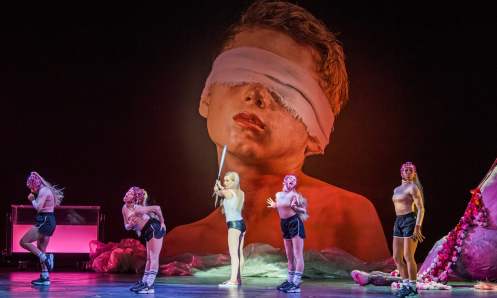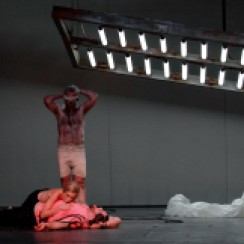Salome
Obtuse Obsessions
Salome
by Richard Strauss, based on Oscar Wilde’s play
English National Opera, London Coliseum until 23rd October
Review by Suzanne Frost
This autumn, ENO is promising a season exploring masculinity and what patriarchal structures may mean, opening with a highly anticipated Salome in a directorial debut by Australian director Adena Jacobs, who promised to present the biblical antihero through a “feminine” lens. Personally, I like tipping well-known stories on their heads and I really like radically reimagined opera – nevertheless, I don’t think I have ever left a theatrical production more baffled and confused. All my efforts at trying to create meaning and get inside Jacobs’ many directorial ideas and choices pretty much ran into nothing so in order to gather my thoughts, this is what I saw:
Herod and his royal family are celebrities with a cult-like following, watched by the ordinary people held behind red ropes. We hear of Salome first through the description of her beauty by a man, the besotted Narraboth. Right from the start, Salome is thus restricted to her appearance and “othered” by her onlooker, compared to a rosebud, a dove – never anything human. When Salome finally appears, a role with more feminist icon burdening and preconceptions than anyone should carry, she sneaks onto the stage almost unnoticed. The Scottish mezzo-soprano Allison Cook is small and slim with a very young face. This Salome is obviously barely a teenager, which makes the luring of all the men over her body and the discomfort of her mother witnessing their lust very poignant. The voice of the prophet Jokanaan comes from out of space like the voice of God, spiting misogynist phrases about women being “the whores of Babylon” with a conviction as if they were eternal truths. Salome, for some obscure reason, is intrigued by this and this is the first time we see her using her femininity to exude power, ever twirling her long blond hair until Narraboth leads her to the prison where the prophet is kept.
He is stripped to his underwear, wrapped in a plastic sheet and sporting a pair of bright pink high heels. This image made me think of Abu Ghraib, but I am not entirely sure why. Some kind of sexualised torture seems to be going on, and the high heels – usually a symbol of femininity as well as oppression are maybe used as a tool to humiliate Jokanaan? He who repeatedly states his contempt for women would probably feel shame being forced into lady’s shoes? It’s my best guess. Where the prisoners of Abu Ghraib had their heads covered in bags, Jokanaan is forced to wear a construction around his face that looks like a futuristic muzzle and films his mouth in close up projected on to the back of the bare stage. His soft mobile lips and the wet tongue rolling around as he sings look somewhat pornographic, like a money shot of a male mouth, and Salome’s sexualised obsession with Jokanaan’s mouth, hair and flesh are maybe the male gaze she continuously endures thrown right back at the patriarchy – but again, I’m only guessing.
While Salome sings herself into ecstasy and starts to strip off her clothes, a lurking Narraboth holds a voyeuristic camera firmly on her, documenting her sexual awakening that the great storyteller Strauss filters through the most glorious music. Salome, topless, in men’s trousers and her platinum hair comes out of her trance now looking like Lady Gaga in Born This Way and steps into Jokanaan’s pink high heels. They must mean something.

The pop culture references and music video aesthetic continues with Herod awakening in his royal bed surrounded by “bitches” like a rapper in a hip hop video. The stage resembles a super hip art gallery, a blank white box with arty installations placed in random corners – Damian Hirst’s shark tank filled with a milky white liquid; a gigantic beheaded My Little Pony suspended from the ceiling like Jeff Koon’s lobster, later gutted and spilling garlands of flowers. A plastic sheet that maybe Joseph Beuys carefully crumpled in a corner in the name of art. Everything is millennial pink and artificial, even a spill of blood from Narraboth is bright pink paint that Herod rolls around in. He is dressed as Santa and will at some point produce lots of presents out of a sack. There is obviously an overload of symbolism here but what it means – I cannot say. Most of the time I felt like being at Whitechapel Gallery or any other fiercely arty hipster venue, looking at a random collection of mystifying objects that might be art or somebody’s discarded plastic bag and wondering if I am just too uncool and stupid for it all. The backdrop switches to an oversized image of a young boy with lipstick, his eyes bound. Maybe Herod just acquired a David La Chapelle portrait of Saint Sebastian for his art collection. Who knows? Sometimes I felt like being at Berlin’s Schaubühne, where theatre just isn’t theatre without some nudity and bodily or other fluids to smear all over people.

Salome returns now dressed as a stroppy teenager in hotpants and sneakers, doing a casual sequence of morning yoga. Then she smears her face with make up until she resembles DC Comics heroine Harley Quinn from Suicide Squad. Her dance of the seven veils is a performance of femininity, a sequence of instagrammable poses. She is supported by Herod’s bitches, all underage teenagers twerking through a hypersexualised dance routine, while the stone-faced Salome swings a baseball bat. The head of Jokannaan is delivered in a plastic bag spilling pink paint. It’s a plastic fantastic pink Barbie world this Salome lives in. Of course these are all symbols of girlhood, but I don’t know if just throwing symbols on stage is enough as a concept. Salome never kisses the head. I don’t think it was ever about love for her. Just exuding power and winning. Maybe she was just pissed off with Jokanaan’s comments about the “race” of women being the evil of the world. I know I was. In the end she seems to miss the male gaze that made her so uncomfortable all through the opera, exclaiming ever more desperate “why did you not look at me, Jokanaan” while the backdrop seems to be a gigantic eye framing her.

Then, Salome has a bonding moment with her mother Herodias, who has been watching Salome’s growing emancipation with pride and admiration, maybe witnessing a new generation of women going further than she ever could. I really want to get on board with feminist opera but I wish it wouldn’t be this confusing. Strauss’ music sounded sublime under Martyn Brabbins, ENOs new Music Director, and Allison Cook has stamina and presence in this most demanding role and she was game for all the directorial nonsense, acting her socks off. It probably wasn’t nonsense. I assume a lot of intellectual conception went into this and maybe I just wasn’t smart enough to get it – but this is not a particularly great feeling to release an audience into the night with.
Suzanne Frost
September 2018





Trackbacks & Pingbacks